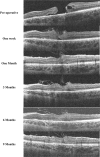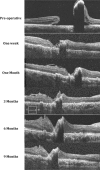Inverted Internal Limiting Membrane Flap For Large Traumatic Macular Holes
- PMID: 26817894
- PMCID: PMC4998268
- DOI: 10.1097/MD.0000000000002523
Inverted Internal Limiting Membrane Flap For Large Traumatic Macular Holes
Abstract
The aim of the study was to assess the role of inverted internal limiting membrane flap as a treatment option for large traumatic macular holes.This is a prospective noncomparative study in which 12 eyes with large traumatic macular holes (basal diameter of 1300-2800 μm) since 3 to 6 months were subjected to standard 23-gauge vitrectomy with removal of the posterior hyaloid, brilliant blue G (BBG)-assisted internal limiting membrane peeling in a circular fashion keeping it attached to the edge of the hole to create a flap. At the end of the surgery, air fluid exchange was done with inversion of the internal limiting membrane flap inside the macular hole using the soft tipped cannula and sulfur hexafluoride 20% as tamponade. The main follow-up measures are the best corrected visual acuity and the optical coherence tomography for 6 to 9 months.All the included eyes had a closed hole from the first week postoperative and along the follow-up period (6-9 months). The best corrected visual acuity improved from 20/2000 to 20/200 with a median of 20/400 preoperatively to 20/400 to 20/50 with a median of 20/100 at the end of follow-up period.Inverted internal limiting membrane flap is a good adjuvant to standard vitrectomy in the management of large traumatic macular holes that led to the 100% closure rate and improvement of best corrected visual acuity.
Conflict of interest statement
The authors have no funding and conflicts of interest to disclose.
Figures




References
-
- Delori F, Pomerantzeff O, Cox MS. Deformation of the globe under high-speed impact: its relation to contusion injuries. Invest Ophthalmol 1969; 8:290–302. - PubMed
-
- Yanagiya N, Akiba J, Takahashi M, et al. Clinical characteristics of traumatic macular holes. Jpn J Ophthalmol 1996; 40:544–547. - PubMed
-
- Barreau E, Massin P, Paques M, et al. Surgical treatment of post-traumatic macular holes. J Fr Ophtalmol 1997; 20:423–429. - PubMed
-
- Johnson RN, McDonald HR, Lewis H, et al. Traumatic macular hole: observations, pathogenesis, and results of vitrectomy surgery. Ophthalmology 2001; 108:853–857. - PubMed
-
- Rubin JS, Glaser BM, Thompson JT, et al. Vitrectomy, fluid-gas exchange and transforming growth factor– beta-2 for the treatment of traumatic macular holes. Ophthalmology 1995; 102:1840–1845. - PubMed
Publication types
MeSH terms
LinkOut - more resources
Full Text Sources
Other Literature Sources

